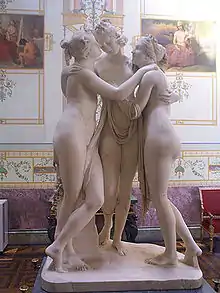Aglaea
Aglaea (/əˈɡliːə/) or Aglaïa (/əˈɡlaɪə/; Greek: Ἀγλαΐα "splendor, brilliant, shining one") is the name of several figures in Greek mythology, the best known of which is one of the three Charites or Gratiae (Graces).
| Aglaea | |
|---|---|
Goddess of grace, charm, and splendor | |
| Member of The Charites | |
 Aglaea (center), as depicted in Antonio Canova’s sculpture, The Three Graces. | |
| Affiliation | Aphrodite |
| Major cult centre | Boeotia |
| Abode | Mount Olympus |
| Personal information | |
| Parents | Zeus and Eurynome |
| Siblings | Euphrosyne and Thalia |
| Spouse | Hephaestus |
| Children | Eucleia, Eupheme, Euthenia, and Philophrosyne |
Mythology
Aglaea is the Greek goddess of beauty, splendor, glory, magnificence, and adornment.
She is the youngest of the Charites according to Hesiod.[1] Aglaea is one of three daughters of Zeus and either the Oceanid Eurynome, or of Eunomia, the goddess of good order and lawful conduct. Her two sisters are Euphrosyne, the goddess of joy or mirth, and Thalia, the goddess of festivity and rich banquets.[2][3] Together they are known as the Charities in Greek mythology or the Gratiae (Graces) in Roman mythology, and they were responsible for overseeing all feasts and dances.[4] They were part of the retinue of Aphrodite with Aglaea sometimes acting as her messenger.[5]
Aglaea was also known as Charis (the Grace) and Kale (Beauty).[6] Aglaea was married to Hephaestus, typically seen as after his divorce from Aphrodite, and by him she became mother of Eucleia ("Good Repute"), Eupheme ("Acclaim"), Euthenia ("Prosperity"), and Philophrosyne ("Welcome").[1][7]
References
| Look up Aglaea in Wiktionary, the free dictionary. |
Notes
Sources
- Grimal, Pierre, The Dictionary of Classical Mythology, Wiley-Blackwell, 1996, ISBN 978-0-631-20102-1. "Charites" p. 99
- Smith, William; Dictionary of Greek and Roman Biography and Mythology, London (1873). "Charis"